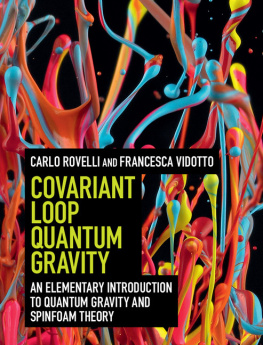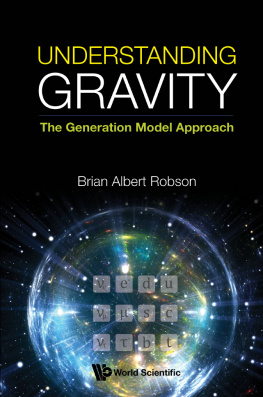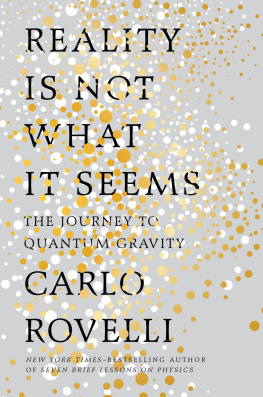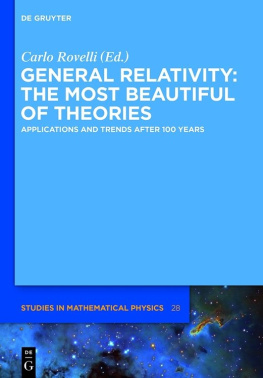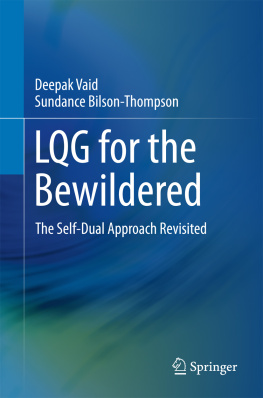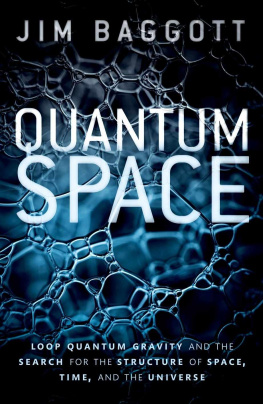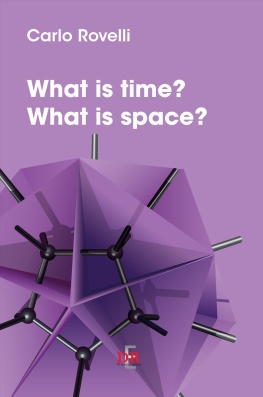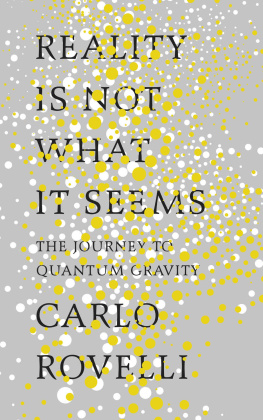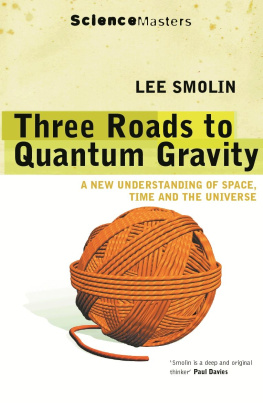Covariant Loop Quantum Gravity
Quantum gravity is among the most fascinating problems in physics. It modifies our understanding of time, space, and matter. The recent development of the loop approach has allowed us to explore domains ranging from black hole thermodynamics to the early universe.
This book provides readers with a simple introduction to loop quantum gravity, centred on its covariant approach. It focuses on the physical and conceptual aspects of the problem and includes the background material needed to enter this lively domain of research, making it ideal for researchers and graduate students.
Topics covered include quanta of space, classical and quantum physics without time, tetrad formalism, Holst action, lattice gauge theory, Regge calculus, ADM and Ashtekar variables, PonzanoRegge and TuraevViro amplitudes, kinematics and dynamics of 4d Lorentzian quantum gravity, spectrum of area and volume, coherent states, classical limit, matter couplings, graviton propagator, spinfoam cosmology and black hole thermodynamics.
Carlo Rovelli is Professor of Physics at Aix-Marseille Universit, where he directs the gravity research group. He is one of the founders of loop quantum gravity.
Francesca Vidotto is NWO Veni Fellow at the Radboud Universiteit Nijmegen and initiated the spinfoam approach to cosmology.
The approach to quantum gravity known as loop quantum gravity has progressed enormously in the last decade and this book by Carlo Rovelli and Francesca Vidotto admirably fills the need for an up-to-date textbook in this area. It will serve well to bring beginning students and established researchers alike up-to-date on developments in this fast moving area. It is the only book presenting key results of the theory, including those related to black holes, quantum cosmology and the derivation of general relativity from the fundamental theory of quantum spacetime. The authors achieve a good balance of big ideas and principles with the technical details.
Lee Smolin, Perimeter Institute for Theoretical Physics
This is an excellent introduction to spinfoams, an area of loop quantum gravity that draws ideas also from Regge calculus, topological field theory and group field theory. It fills an important gap in the literature offering both a pedagogical overview and a platform for further developments in a forefront area of research that is advancing rapidly.
Abhay Ashtekar, The Pennsylvania State University
Covariant Loop Quantum Gravity
An Elementary Introduction to Quantum Gravity and Spinfoam Theory
CARLO ROVELLI
Universit d Aix-Marseille
FRANCESCA VIDOTTO
Radboud Universiteit Nijmegen


University Printing House, Cambridge CB2 8BS, United Kingdom
Cambridge University Press is part of the University of Cambridge.
It furthers the Universitys mission by disseminating knowledge in the pursuit of education, learning and research at the highest international levels of excellence.
www.cambridge.org
Information on this title: www.cambridge.org/9781107069626
C. Rovelli and F. Vidotto 2015
This publication is in copyright. Subject to statutory exception and to the provisions of relevant collective licensing agreements, no reproduction of any part may take place without the written permission of Cambridge University Press.
First published 2015
Printed in the United Kingdom by TJ International Ltd. Padstow Cornwall
A catalogue record for this publication is available from the British Library
ISBN 978-1-107-06962-6 Hardback
Cambridge University Press has no responsibility for the persistence or accuracy of URLs for external or third-party internet websites referred to in this publication, and does not guarantee that any content on such websites is, or will remain, accurate or appropriate.
To our teachers and to all those who teach children to question our knowledge, learn through collaboration, and feel the joy of discovery
This book is an introduction to loop quantum gravity (LQG) focusing on its covariant formulation. The book has grown from a series of lectures given by Carlo Rovelli and Eugenio Bianchi at Perimeter Institute during April 2012 and a course given by Rovelli in Marseille in the winter of 2013. The book is introductory, and assumes only some basic knowledge of general relativity, quantum mechanics, and quantum field theory. It is simpler and far more readable than the loop quantum gravity text Quantum Gravity (Rovelli ).
There is a rich literature on LQG, to which we refer for all the topics not covered in this book. On quantum gravity in general, Claus Kiefer has a recent general introduction Kiefer (). At the time of writing, Ashtekar and Petkov are editing a Springer Handbook of Spacetime, with numerous useful contributions, including that of John Engles article on spinfoams.
A fine book with much useful background material is that of John Baez and Javier Munian (). The very early form of the theory and the first ideas giving rise to it can be found in the 1991 book by Abhay Ashtekar.
A good recent reference is the collection of the proceedings of the 3rd Zakopane school on loop quantum gravity, organized by Jerzy Lewandowski (Barrett et al. ), for a careful and useful introduction to and reference for the mathematics of spin networks.
We are very grateful to Klaas Landsman, Gabriele Stagno, Marco Finocchiaro, Hal Haggard, Tim Kittel, Thomas Krajewski, Cedrick Miranda Mello, Aldo Riello, Tapio Salminem and, come sempre, Leonard Cottrell, for careful reading of the notes, corrections, and clarifications. Several tutorials have been prepared by David Kubiznak and Jonathan Ziprick for the students of the International Perimeter Scholars: Andrzej, Grisha, Lance, Lucas, Mark, Pavel, Brenda, Jacob, Linging, Robert, Rosa; thanks also to them!
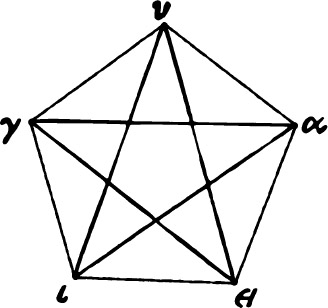
FOUNDATIONS
| Spacetime as a quantum object |
This book introduces the reader to a theory of quantum gravity. The theory is covariant loop quantum gravity (covariant LQG). It is a theory that has grown historically via a long, indirect path, briefly summarized at the end of this chapter. The book does not follow the historical path. Rather, it is pedagogical, taking the reader through the steps needed to learn the theory.
The theory is still tentative for two reasons. First, some questions about its consistency remain open; these will be discussed later in the book. Second, a scientific theory must pass the test of experience before becoming a reliable description of a domain of the world; no direct empirical corroboration of the theory is available yet. The book is written in the hope that some of you, our readers, will be able to fill these gaps.
This first chapter clarifies what is the problem addressed by the theory and gives a simple and sketchy derivation of the core physical content of the theory, including its general consequences.
1.1 The problem
After the detection at CERN of a particle that appears to match the expected properties of the Higgs [ATLAS Collaboration (2012); CMS Collaboration (2012)], the demarcation line separating what we know about the elementary physical world from what we do not know is now traced in a particularly clear-cut way. What we know is encapsulated into three major theories:
Next page
